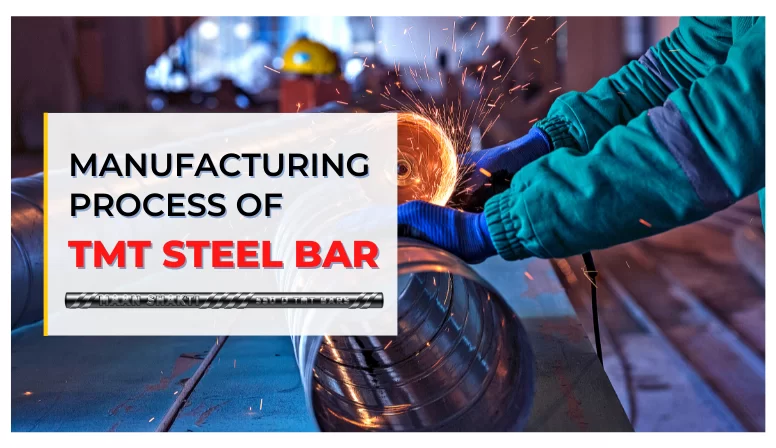The manufacturer of TMT Barslets the raw materials pass through various processes that help build its robustness and flexibility. The entire manufacturing process involves rolling, heat treatment at different stages, quenching, self-tempering, and leaving the final product for atmospheric cooling.
From the above, we can say that the entire manufacturing process revolves around four major components:
- Heat treatment at various stages.
- Quenching.
- Self-tempering
- Atmospheric cooling
The last and not the least is the process that Top rated TMT Steel Bar Manufacturers adopt is checking the quality of the product at various stages of manufacturing. Each of the leading producers in our country has a quality inspection team. Quality checking ensures rectifying any error in the measure of production or others at its inception. It also helps the company maintain its reputation.
Steps of TMT Bars Production
Converting Virgin Iron to Steel
Virgin iron ore is the best material to produce quality TMT bars. Manufacturing teams in India also use coal and dolomite in the conversion process. The iron ore passes through the beautification process at the beginning. The process involves raw material treatment to improve its physical or chemical properties. The process works best during smelting.
The process team gathers metallic lines to reshape the grown iron as pellets and sinters. Such formation brings up metal with more efficiency. They convert the coal to coke for future uses.
Dolomite accompanies the process at this juncture. The use of limestone helps molt the pellets and sinters via the passage of hot air. The impurities in these metallic substances float on the surface of the molten material.
Making of Steel
Steel making has two stages – pre-treatment and post-treatment. The manufacturing team pours semi-matured iron ore into an oxygen furnace in the pre-treatment stage. The oxygen combines with the carbon in the ore. Carbon dioxide produced in the process passes off, leaving more pure metal.
The resultant material passes through an Electric Arc Furnace to get a better lining of the metallic steel composition.
The molten metal passes to the cooling mold via a continuous casting ladle. The purified metal starts solidifying in the mold. The processing team sizes those pieces according to needs in another machine.
Thermo Mechanical Treatment
TMT bars stand for Thermo Mechanical Treated Bars. The bars produced in the factory pass through different handling methods. These include:
Quenching
Top rated TMT Steel Bar Manufacturersuse Thermex Technology during the quenching process. Once the processed bars come out of the sizing device, the manufacturing team passes them through a Water Jet system.
The flush drenches the bars entirely. The team takes special measures so that only the outer space, i.e., the surface, is under the water and gets the effect of jet flow. The application of cold water hardens the surface area of the bars, forming martensitic rims. The inner core of the bars stays hot and austenitic.
Quenching helps increase the level of hardness in the TMT steel bars. Bars with better hardness bestow distinguished strength in the bars.
Experts in the trade measure those strengths with grades. The team offers rapid cooling at various levels for different bars. The bars exhibit strength according to the martensite formed at the surface.
Self-Tempering
It is the stage when the outer core of the TMT bars gets temperament on its own. As the TMT Bars team manufacturer releases the bars from the quenching box, the inner core is at a more heated stage than the surface. The heat thus passes from the inner core to the surface following the heat passage principles.
Passage of heat from the inner core to the outer causes convectional tempering of the surface. According to experts, temperament accounts for a correct reconditioning of the martensitic layer. The outer layer of the TMT bars thus arrives as a combination of martensitic and bainitic formation. The inner core, however, remains hot and austenitic. It is the ideal form of TMT bars in India.
Atmospheric Cooling
Users or study observers may wonder – The jet process is over. What is the need for atmospheric cooling? Yes. Manufacturing teams require the process to balance the temperature difference between TMT bars’ surface and inner core. Gradual cooling in air converts the hot and austenitic inner core into a ferrite-pearlite structure. The surface remains strong as ever. Proper cooling thus increases the tensile strength of the TMT bars making the bars more ductile, malleable, and weldable.
Quality Assessment
Determining the quality of the produced bars is an essential part of the TMT bars manufacturing process. Manufacturer of TMT Bars conducts quality assessments at the turns of necessary procedures. Quality assessment depends on the following factors:
- The machinery the manufacturing team uses for quenching and self-tempering.
- Quality of the basic materials used in the process.
Final words
Leading Manufacturers of TMT Bars in India carry on the entire process, starting from generating steel to cooling the final product under a single roof. The ability to persist with quality in the final product has helped companies like Maan TMT to gather a distinguished reputation. Top construction companies in our country trust Maan TMT for its intuitive nature.


Leave a Reply